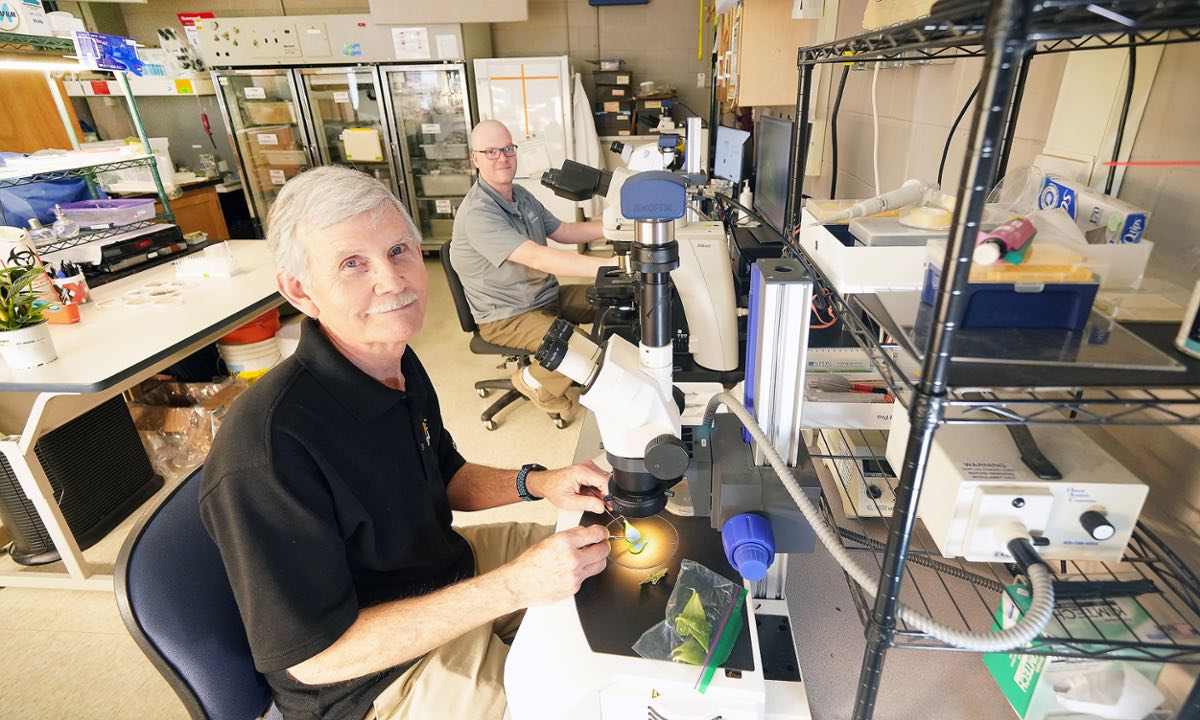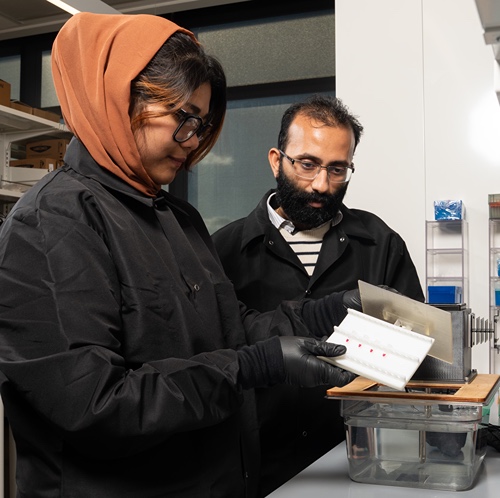Purdue Extension specialist brings updated management techniques to fields and orchards
George Brenn, president and general manager of Four Seasons Landscaping Nursery in Valparaiso, Indiana, immediately recognized a problem in a shipment of plants from a wholesale grower. Fifty Rudibeckia (black-eyed Susans) were infected with downy mildew. Brenn didn’t know much about the disease, so he called Janna Beckerman at Purdue to ask if cutting back the plants might save them.
Beckerman, professor of botany and plant pathology, emphatically said no. The disease is systemic, she told him; not only should he throw away the plants, but he must also discard the containers they came in. “Never would I have thought about the residual,” Brenn says, relieved to limit its impact in his nursery.
He continues to rely on Beckerman’s expertise, not only for his business, but also in his leadership of the Indiana Accredited Horticulture Program and Indiana Nursery and Landscape Association.
As a specialist in diagnosing and managing diseases of horticultural crops, Beckerman is among Purdue Extension specialists in wide-ranging fields who translate research to application for stakeholders statewide. In turn, grower input informs her research.
Beckerman has written Extension publications and spoken often at grower events throughout the state since joining Purdue’s botany and plant pathology faculty in 2005. Through her integrated teaching, research and Extension efforts, she has established long-standing and productive relationships with growers and landscape managers.
“Janna has a way of putting technical information forward so that it makes perfect sense,” Brenn says.
Efforts to solve a problem may begin with a phone call or a plant sample submitted to the Purdue Plant and Pest Diagnostic Lab. The PPDL — a service for Extension specialists and educators, researchers, and Indiana businesses and citizens — diagnoses plant diseases and other plant and pest problems. There Beckerman works with lab director Tom Creswell and John Bonkowski, plant disease diagnostician. “I couldn’t do what I do without their critical support,” she says. For some problems or diagnoses, a site visit might follow.
 Tom Creswell (left) and John Bonkowski in Purdue's Plant and Pest Diagnostic Lab frequently collaborate with Beckerman
Tom Creswell (left) and John Bonkowski in Purdue's Plant and Pest Diagnostic Lab frequently collaborate with Beckerman “I probably talk to Janna two to five times a year with questions on new fungicides or disease problems,” says Brian Garwood, who with his brother and cousin, are sixth-generation owners of Garwood Orchard and Farm Market in La Porte, Indiana. The Garwoods grow about 30 different crops on 500 acres and employ 120 people.
Beckerman had to prove herself with the state’s old-time growers, Garwood says.
“Everybody was a little leery. But she’s up to date on things and eager to help out any time we’ve ever asked.”
Beckerman’s Extension work focuses on Indiana but extends throughout the Midwest. Jean-Marc Versolato, Midwest plant health manager for Minneapolis-based Bailey Nurseries, started working with her when she was at the University of Minnesota more than 25 years ago.
Versolato continues to contact Beckerman for help — for example, when found himself dealing with a serious outbreak of powdery mildew in his greenhouses. “Purdue is useful to growers because the information is practical, and Janna is results-oriented. She’s going to save you time and pain when she tells you, ‘This is the fungicide, this is the rotation, this is the rate.’”
Bailey Nurseries has farms in several states and more than 1,000 employees. Beckerman works with companies of all sizes, from large commercial operations to mom and pop greenhouses.
If a smaller business has a major disease outbreak and loses the crop, they could lose their business. It deserves the same care and consideration as the larger growers.”
- Janna Beckerman, professor of botany and plant pathology
Beckerman’s research focuses on how different fungicides perform, including sequences or combinations as well as application techniques, to optimize how growers use these products. “If they’re using them most efficiently and also most effectively, they don’t have to use as much, or use it as often — and that has long-term implications on the environment,” she says.
Growers are increasingly seeking this information, she adds. “As the value of crops increase and it’s harder to get labor, protecting these crops becomes more important to the bottom line.”
The changing climate is impacting Indiana growers, too. Beckerman cites the increasing frequency of apple harvests lost to freeze, mirrored in her own research plots.
Climate change also affects plant health. In 2009, Indiana apple growers started reporting problems with bitter rot, a disease that previously had minimal impact. Suddenly entire blocks of specific cultivars were lost, Beckerman says, and things were getting worse.
She worked with one large apple operation that lost its entire Honeycrisp crop. “Honeycrisp is what brings people into the orchards so that is devastating, and this grower wasn’t alone,” Beckerman says. Consumers love these newer varieties for their crunch and flavor, but they tend to be more susceptible to bitter rot.
As a result, Beckerman has spent much of the last decade working on better management of the disease. While she has focused on apples, this past year strawberries, grapes, and ornamentals like peonies and crabapples have also needed her attention.
She heads a multistate working group that produces a Midwest Fruit Pest Management Guide that growers rely on for recommendations to address problems and navigate an array of fungicides, which might work in one stage of a particular fruit’s development but not in another.
Garwood finds the spray guide especially valuable because accurate spray records are essential to his certification for produce safety, which allows him to sell to grocery stores and other users.
Beckerman updates fungicide information as regulations change. “A lot of the products that growers have relied on are under heightened scrutiny right now to make sure they are not only safe for human health but for the broader ecosystem as well,” she says.
“I know how complicated it is and how many gears are in motion when you’re trying to bring a crop a harvest,” she adds. “Anything I can do to make it easier translates into growers being more successful.”






